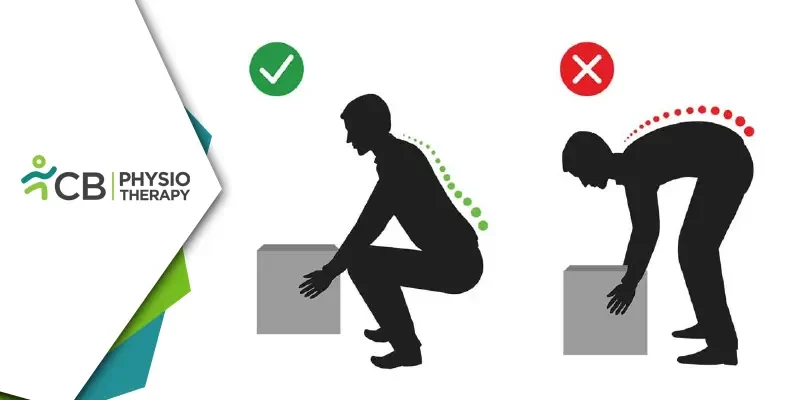Lifting heavy objects is a common task in both our personal and professional lives. However, improper lifting techniques can lead to serious injuries, such as strains, sprains, and herniated discs. To avoid these problems, consult a qualified physiotherapist to promote musculoskeletal health and prevent injuries. In this comprehensive guide, we will share the best and safest way to lift heavy objects, providing valuable insights and practical tips to protect your back and overall well-being.
Understanding the Mechanics of Lifting
Before delving into the proper techniques, it's crucial to understand the mechanics of lifting. When lifting heavy objects, particularly from the ground, significant stress is placed on the spine and supporting structures. The lower back, or lumbar spine, is particularly vulnerable to injury if not properly supported during the lifting process. Proper technique involves minimizing stress on the lumbar spine and relying on strong, stable core muscles to bear the load.
Best and Safest Way to Lift Heavy Objects:
Follow these guidelines and steps to ensure safe lifting:
1. Assess the Load:
Before lifting, evaluate the object's weight and size. If it appears too heavy or awkward to lift on your own, seek assistance or use lifting aids like dollies or hand trucks.
2. Plan Your Approach:
Plan your lifting strategy and identify the best path to your destination. Clear any obstacles in your path to avoid tripping or stumbling during the lift.
3. Warm-Up:
Prepare your body for the task by performing dynamic warm-up exercises that target the hips, hamstrings, and core. Warming up increases blood flow to the muscles, making them more pliable and less prone to injury.
4. Position Your Feet:
Stand with your feet shoulder-width apart, with one foot slightly ahead of the other for balance and stability. Avoid lifting with your feet too close together, as it compromises your balance.
5. Squat to Lift:
Bend your knees and hips to lower yourself into a squatting position while keeping your back straight. Avoid bending at the waist to minimize stress on the lower back.
6. Use Proper Grip:
Maintain a secure grip on the object using both hands. If possible, wear gloves to improve your grip and protect your hands.
7. Engage Your Core:
Before lifting, engage your core muscles, including the transverse abdominis and pelvic floor, to stabilize your spine. Imagine bracing your midsection as if someone were about to punch you.
8. Lift with Your Legs:
As you lift the object, use the power of your legs to push through the heels and straighten your hips and knees. Your leg muscles are much stronger than your back, and using them to lift reduces strain on the spine.
9. Keep the Object Close:
Hold the object close to your body to reduce the load on your lower back and maintain better control over the weight.
10. Avoid Twisting:
While lifting and carrying, avoid twisting your body. Instead, pivot with your feet to change direction, reducing strain on your spine.
11. Take Breaks:
If you need to transport a heavy object over a long distance, take frequent breaks to rest and avoid overexertion.
12. Lower with Control:
When setting down the object, reverse the lifting process by squatting with your legs while keeping your back straight. Lower the object with control to avoid sudden jolts or impact.
Additional Tips for Safe Lifting:
1. Maintain Good Posture:Practice maintaining good posture throughout the day, as it directly impacts your lifting technique. Regularly perform exercises that strengthen your back, shoulders, and core to support proper posture.
2. Strengthen Your Core:
Regularly engage in core-strengthening exercises like planks, bridges, and dead bugs to provide a stable foundation for lifting heavy objects.
3. Avoid Overreaching:
When lifting, avoid overreaching for objects. Instead, reposition yourself closer to the item to maintain a stable base during the lift.
4. Communicate and Collaborate:
If you're lifting heavy objects with others, communicate and coordinate your movements to ensure everyone is on the same page. Working together reduces the risk of accidents and injuries.
5. Know Your Limits:
Be realistic about your strength and limitations. If an object is too heavy or awkward to lift safely, seek help or use mechanical aids.
6. Use Proper Footwear:
Wear sturdy, supportive footwear with non-slip soles when lifting heavy objects to maintain stability and reduce the risk of slips or falls.
7. Avoid Repetitive Lifting:
If possible, avoid repetitive lifting of heavy objects. If the task is unavoidable, take breaks and stretch between lifts to minimize muscle fatigue and strain.
Lifting heavy objects is a routine part of life, but it should never be taken lightly. Adopting proper lifting techniques is essential to prevent musculoskeletal injuries and promote overall well-being. As a physiotherapist, my priority is to help individuals lift safely and protect their backs from unnecessary strain.
By following the guidelines provided in this comprehensive guide, you can significantly reduce the risk of injury while lifting heavy objects. Remember to prioritize proper posture, engage your core muscles, and use the power of your legs when lifting. If you have any pre-existing back conditions or concerns, consult with a physiotherapist or healthcare professional before attempting any heavy lifting tasks.
Incorporate regular strength training and core exercises into your fitness routine to develop a strong foundation for safe lifting. By being mindful of your body's capabilities and following these safe lifting practices, you can confidently and safely tackle any heavy lifting task that comes your way.

